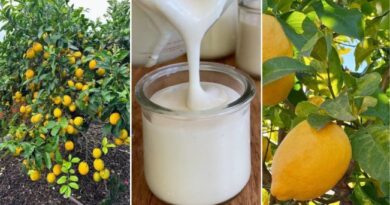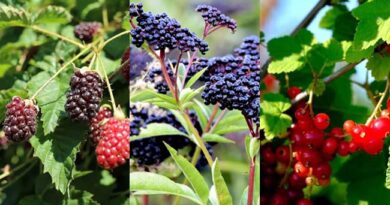World’s Top 60 Mango Varieties by Flavor, Color & Region
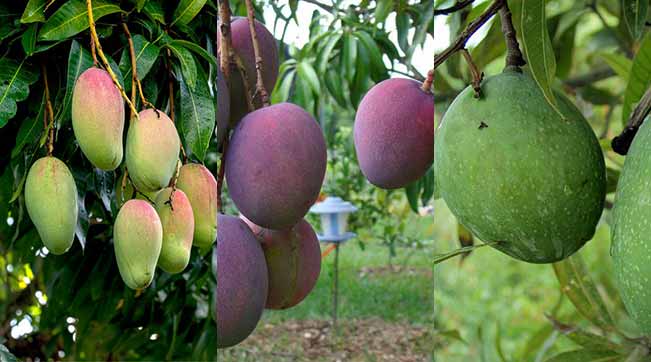
Have you ever bitten into a juicy mango and thought, “Wow, this is the best fruit ever”? You’re not alone! Mangoes are often called the “king of fruits,” and for good reason. They’re sweet, juicy, refreshing, and full of tropical flavor. But did you know there are over 1,000 types of mangoes in the world? That’s right! Each variety has its own taste, smell, size, and color.
Whether you like your mangoes sweet, tangy, firm, or super juicy, there’s a perfect one out there waiting for you. Let’s take a fun journey through some of the most famous and tasty mango varieties from around the world !
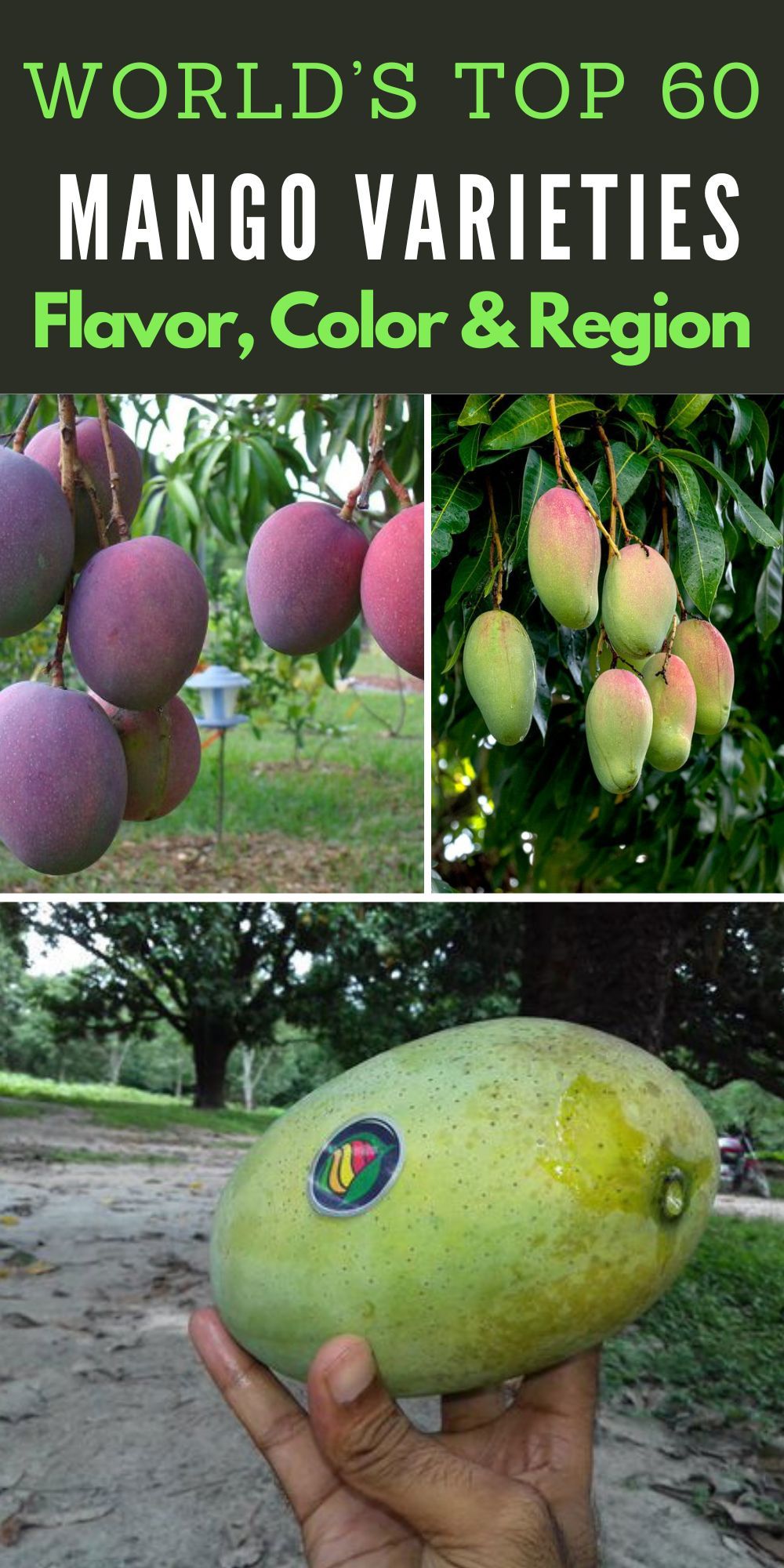
Different Types of Mangoes in Thailand
1 Nam Dok Mai

Flavor: Sweet and fragrant
Flesh: Thick and juicy
Nam Dok Mai is one of Thailand’s most famous mango varieties. It’s prized for its elegant sweetness and aromatic flavor. The fruit is elongated with yellow skin and contains a lot of soft, juicy flesh with very few fibers. These mangoes are ideal for fresh eating, but they’re also widely used in smoothies, drinks, and desserts like mango sticky rice.
2 Khieo Sawoei Sampran

Flavor: Crunchy and mildly sweet
Flesh: Firm and crisp
This mango is usually eaten while still green and tart. Khieo Sawoei Sampran mangoes are small and oblong, and when unripe, they offer a crunchy texture and refreshing acidity. In Thailand, they are commonly enjoyed with a dipping sauce made from fish sauce, chili, and sugar. As they ripen, the skin turns pale yellow, but many prefer them before they fully mature.
3 Tong Dam

Flavor: Very sweet and rich
Flesh: Soft with slight fibers
Also known as “Black Gold,” the Tong Dam mango is a rare variety in Thailand. It features a deep yellow to orange flesh that’s sweet, juicy, and slightly fibrous. Though not widely available, it is treasured for its excellent flavor and smooth, dessert-like quality. These mangoes are usually eaten fresh and are sought after during the peak mango season.
4 Mamuang Ok Rong
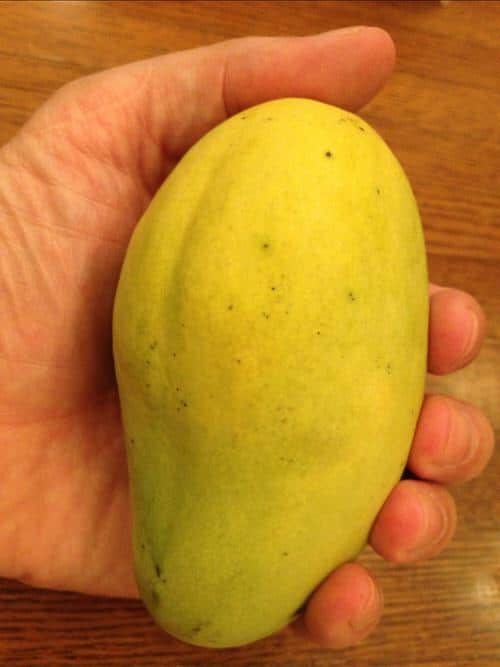
Flavor: Intensely sweet
Flesh: Firm and fiberless
Mamuang Ok Rong is a premium Thai mango highly valued for its use in traditional desserts like mango sticky rice. The fruit has a long shape and turns golden yellow when ripe. Its firm, fiber-free flesh has a rich sweetness that makes it perfect for both eating fresh and using in culinary dishes. It’s one of the more expensive varieties due to its superior quality and limited supply.
5 Ivory
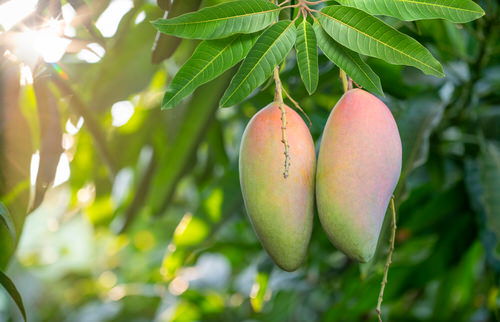
Flavor: Sweet and clean
Flesh: Bright yellow, smooth, very low in fiber
Originally from Thailand, Ivory mangoes were introduced to China in the early 20th century. The name comes from the fruit’s long and slender shape, which resembles an ivory tusk. The tree that first arrived in China is said to still bear fruit today. These mangoes are known for their clean sweetness and soft, fiberless flesh that makes up a large portion of the fruit—about 82% of the total weight.
Different Types of Mangoes in Japan
6 Miyazaki – World’s Costliest Mango!

Flavor: Sweet, creamy, and rich
Flesh: Deep red, smooth and soft
The Miyazaki mango is one of the most luxurious mangoes in the world, named after Japan’s Miyazaki Prefecture where it’s cultivated. Originally from a variety developed in California, it’s now grown under precise conditions to ensure maximum sweetness and color. These mangoes are prized for their intense flavor and are often sold in elegant packaging, with prices reaching over $3,000 per kilogram in auctions.
Different Types of Mangoes in the Philippines
- Carabao

Flavor: Extremely sweet and aromatic
Flesh: Soft, juicy, and golden yellow
The Carabao mango, also called the Manila mango, is one of the most popular mango varieties in the Philippines. It’s recognized by the Guinness World Records as the sweetest mango in the world. The fruit has a thin yellow skin and tender, juicy pulp that melts in the mouth. It’s widely exported and cherished for its rich, tropical flavor.
- Pico (Piko) or Padero
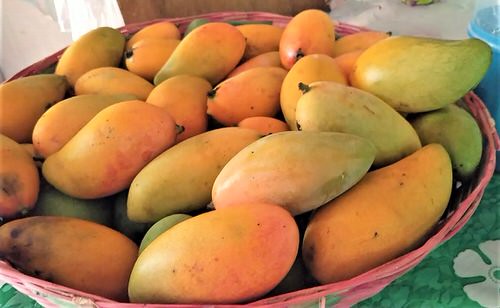
Flavor: Sweet and mellow
Flesh: Pale yellow, creamy, and soft
Pico mangoes are among the most common mangoes grown in the Philippines. They are slightly firmer than Carabao mangoes, but still soft and smooth. The fruit often develops a reddish hue near the tips as it ripens. Its flavor is mildly sweet and balanced, making it ideal for eating fresh or mixing into fruit salads and desserts.
- Pahutan (Pajo)
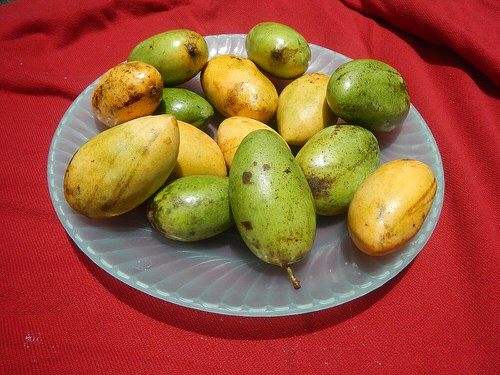
Flavor: Sweet and tart
Flesh: Yellow, pulpy, and fragrant
Pahutan, or Pajo, is a wild mango native to the Philippines and surrounding areas such as Indonesia, Malaysia, and Papua New Guinea. These mangoes are small and oval, with a strong tropical aroma and a sweet-tart taste. They’re not widely cultivated commercially, but are much loved in rural communities. Often eaten green or partially ripe, they’re also used in pickles and local delicacies.
- Katchamita

Flavor: Sweet with a tangy twist
Flesh: Firm, yellow flesh with green skin
Katchamita, often referred to as the Indian mango, has become widely grown in the Philippines. It’s usually enjoyed while still green, when its tartness is balanced with a hint of sweetness. As it ripens, the mango softens and develops a sweeter flavor. This mango is popular for snacking fresh or dipping in salt and vinegar, a common local treat.
Different Types of Mangoes in Jamaica
- Number Eleven

Flavor: Fragrant and sweet, with a tangy aftertaste
Flesh: Firm, yellow pulp
The Number Eleven mango is a well-loved variety in Jamaica, famous for its strong aroma and flavorful flesh. It has a roundish shape and a slightly tangy taste near the seed. Many Jamaicans prefer to squeeze or “juice” this mango by hand before consuming it. While not everyone’s favorite, those who enjoy it consider it uniquely delicious.
- Black/Blackie

Flavor: Very sweet and rich
Flesh: Soft green or yellow pulp with black-spotted, edible skin
Blackie, or Black mango, is a small-sized Jamaican mango known for its strong sweetness and edible skin. The skin is usually marked with black spots, which don’t affect the taste. Its juicy interior and compact size make it a convenient snack, often enjoyed straight from the tree.
- Julie (St. Julian)
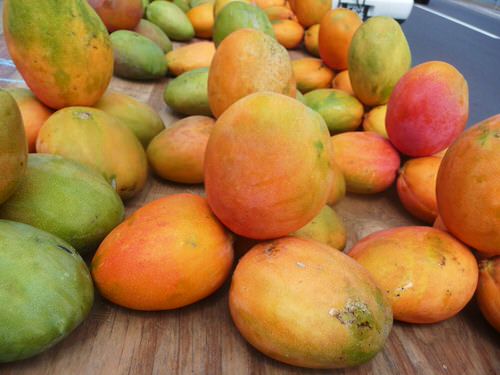
Flavor: Sweet, juicy, and full-bodied
Flesh: Deep orange, smooth, and non-fibrous
Julie, or St. Julian, is one of the most beloved mango varieties in Jamaica. It has a distinct flat shape and a deep, rich flavor. The fruit ripens from green to a reddish-orange hue and is commonly eaten when it’s just starting to soften. Its smooth texture and bold flavor make it a favorite among locals and mango enthusiasts.
- East Indian

Flavor: Strongly sweet and juicy
Flesh: Thick, yellow flesh
The East Indian mango holds a special place in Jamaica’s mango culture. Introduced by Indian laborers in the mid-1800s, it’s known for its generous size and intensely sweet, juicy flesh. The fruit is slightly fibrous but packed with flavor, making it one of the top picks for eating fresh during mango season.
- Rainbow Mango

Taste: Very sweet with a strong tropical smell
Flesh: Golden-yellow, soft, with a single flat seed
Rainbow mango is as colorful in flavor as its name suggests. It’s a special hybrid mango made by crossing two famous types – the Thai Nam Doc Mai and the Indian Minh Chau. This mango doesn’t just look pretty, it smells amazing and tastes like a tropical dream. Its juicy flesh melts in your mouth, and it has just the right amount of sugar to satisfy your sweet tooth. If you want a mango that stands out at first bite, Rainbow is a must-try.
- Honey Mango (Also Called Ataulfo)
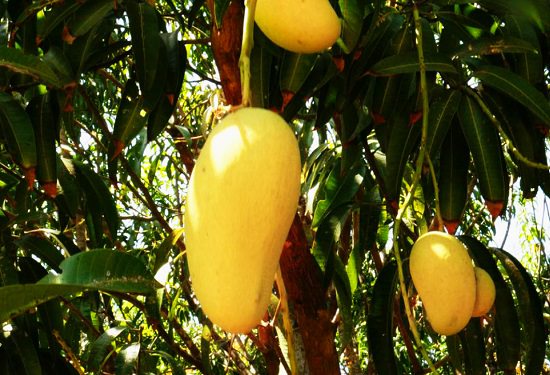
Taste: Sweet with a light sour twist
Flesh: Creamy and smooth with almost no fibers, small seed
Honey Mango is sunshine in fruit form. Small in size but big in flavor, this mango is buttery, smooth, and has a very sweet, tropical flavor with a touch of tartness that makes it more interesting. The skin turns golden yellow when ripe, and the inside is like soft peach-colored pudding. It’s easy to peel, easy to eat, and super popular for mango lovers who don’t like stringy fruit. It’s great in smoothies or just fresh off the peel.
- Francis Mango
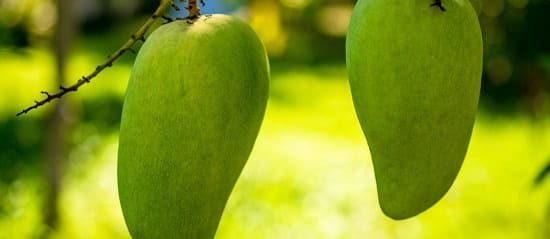
Taste: Sweet and fruity with a strong mango scent
Flesh: Soft, juicy, and a bit fibrous
The Francis mango comes mostly from Haiti and is full of flavor. It’s not just sweet – it has a deep fruity taste that fills your mouth with a tropical vibe. It’s usually available in the U.S. around May and June. The outside is greenish-yellow and gets more golden as it ripens. The inside is juicy with a few fibers, making it a bit stringy but still very enjoyable. It’s the kind of mango you eat when you want to remember summer.
- Haden Mango

Taste: Sweet with a little sourness and a mild bitter aftertaste
Flesh: Firm, juicy, with some fibers and a nice fruity smell
Haden is one of the classic American mangoes, especially known in Florida. It was first grown there in the early 1900s and helped start the mango industry in the U.S. The skin is red with green and yellow shades, and the flesh inside is thick and firm. It’s not overly sweet, which makes it good for people who like a balanced flavor. You’ll often find Haden mangoes in stores during the early mango season.
- Keitt Mango

Taste: Sweet and citrusy
Flesh: Juicy, firm, low in fibers, very clean to eat
Keitt mango is a favorite among people who like to eat mangoes not only when they’re ripe but also when they’re green. When green, it has a tangy taste, and when ripe, it’s super sweet. It has very little fiber, so it’s great for eating fresh or adding to salads and salsas. These mangoes are usually large and oval in shape. They stay green even when ripe, so don’t wait for them to turn yellow – just squeeze gently to check if they’re ready.
- Kent Mango

Taste: Sweet with a light tartness
Flesh: Soft, juicy, very smooth with almost no fiber, and a pleasant peachy fragrance
Kent mangoes are one of the most beloved mango varieties, especially for people who don’t like stringy fruit. They have tender, buttery flesh that’s easy to cut and eat. Grown mainly in Mexico, Ecuador, and Peru, they’re mostly available in the winter months—December through February—when other mango types are harder to find. As the fruit ripens, you’ll notice small yellow specks appear on the green skin. These mangoes are great for making juice, smoothies, or even drying into sweet mango snacks. If you like soft, mellow mangoes with lots of juice, Kent should be on your list.
- Tommy Atkins Mango

Taste: Slightly tart with mild sweetness
Flesh: Firm and fibrous with a citrus-like aroma
Tommy Atkins is like the dependable friend you can always count on. It may not be the sweetest mango in the bunch, but it makes up for it with its strong shelf life, thick skin, and beautiful red-green color. It was first grown in Florida and is now one of the most widely sold mangoes in supermarkets across the United States. The flesh is firmer and more fibrous than other varieties, which makes it great for slicing and using in salads or salsas. You can find Tommy Atkins mangoes from spring through mid-summer, roughly March to July.
- Graham Mango
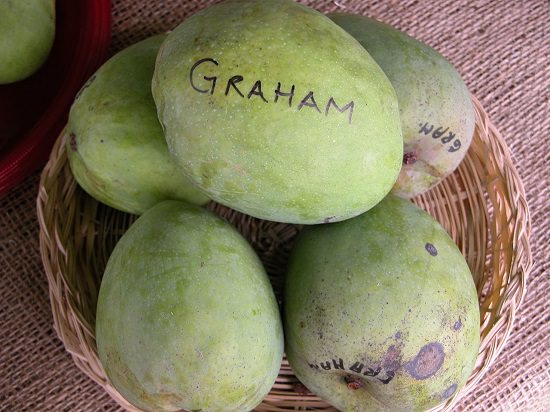
Taste: Rich and sweet
Flesh: Deep orange, fiberless, and aromatic
Graham mango is a lesser-known variety that deserves more attention. It originated in Trinidad and was brought to the U.S. by the USDA in the 1930s. Graham is now a favorite for home gardens because of its sweet flavor and strong resistance to disease. The fruit has a golden skin when ripe and releases a sweet, tropical aroma. The best part? The flesh is completely smooth with no fibers at all. It’s a great mango to eat fresh, straight off the peel, or used in desserts like mango mousse or ice cream.
- Irwin Mango

Taste: Sweet with a hint of apple flavor
Flesh: Golden yellow, smooth, fiberless; red-blushed skin
Nicknamed the “Apple Mango,” Irwin mangoes are famous for their mild, sweet taste and firm flesh. These mangoes were first grown in Florida but are now also popular in countries like Japan, Taiwan, and Australia. The red skin makes them look like apples, which is why they earned their nickname. Inside, the flesh is bright yellow and very clean to eat—no annoying fibers. Irwin mangoes are perfect for fruit salads, snacking, or simply enjoying chilled on a hot day.
- Palmer Mango
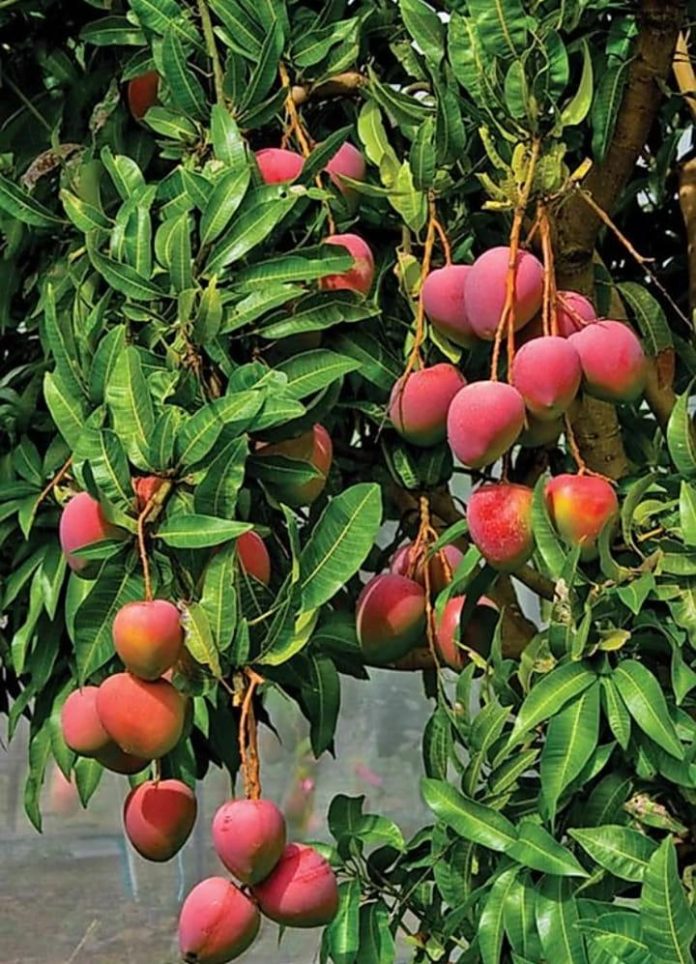
Taste: Sweet, juicy, and smooth
Flesh: Orange-yellow, low fiber, and large in size
Palmer mangoes are known for their impressive size—they’re usually longer and larger than many other varieties. These late-season mangoes are grown mostly in Florida and are harvested from August to October. Their firm, juicy flesh makes them perfect for slicing and serving fresh or mixing into tropical smoothies. Because they contain very little fiber, they’re also great for people who like clean, soft bites without stringiness. If you want a sweet, rich mango that’s easy to prepare, give Palmer a try.
- Valencia Pride Mango

Taste: Very sweet and juicy
Flesh: Golden yellow, silky smooth, completely fiberless
Valencia Pride mangoes look as elegant as they taste. These large, oval mangoes grow in both California and Florida and are known for their gorgeous yellow skin with a soft red blush. They grow quickly and are favored by gardeners for their productivity and size. The flavor is very sweet and floral, making each bite feel luxurious. These mangoes ripen in late summer and are perfect for fresh eating, fruit bowls, or even homemade mango sorbet.
- Kensington Pride Mango (Also Called Bowen Mango)

Taste: Sweet and rich
Flesh: Bright yellow, smooth, with yellow-green or blushed skin
Kensington Pride is the most popular mango in Australia. Locally, it’s often called the “Bowen Mango.” It has a rich, deep flavor that Australians love, and it grows well in home gardens. The skin is usually yellow-green with a splash of red, and the flesh inside is smooth and juicy. This variety peaks from September to February, just in time for summer in the Southern Hemisphere. It’s a great choice for eating fresh or adding to tropical desserts.
- Glenn Mango

Taste: Sweet and juicy with a mild tang
Flesh: Smooth, yellow flesh with no fibers; skin is thin with an orange-red tint
Glenn mangoes are a Florida favorite. They originated from a Saigon seedling planted in the 1940s and quickly became popular for their manageable tree size and high-quality fruit. The mangoes are medium-sized, oval, and develop a lovely golden-orange color with a blush of red when fully ripe. Inside, the flesh is silky smooth, juicy, and has a sweet flavor with a faint hint of acidity that balances it perfectly. Glenn mangoes are usually harvested in early summer and are often enjoyed fresh, sliced, or blended into tropical drinks.
- Sein Ta Lone (Diamond Mango)
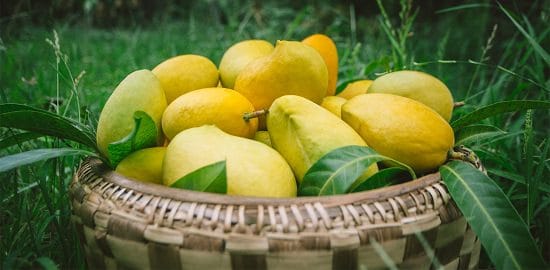
Taste: Intensely sweet and fragrant
Flesh: Juicy, aromatic, low-fiber texture
Sein Ta Lone mangoes, often called “Diamond Mangoes,” are a hidden gem from Myanmar. The name literally means “one diamond” in Burmese, which reflects the mango’s prized status in its home country. These mangoes are rarely found outside Southeast Asia but are gaining attention in specialty markets across the world. The fruit is small to medium in size, has a beautiful golden-yellow color, and the flesh inside is soft, juicy, and bursting with sweetness. If you ever get a chance to try it, don’t miss out—it’s a tropical treasure.
Popular Indian Mango Varieties
India is known as the birthplace of mangoes, and the country grows hundreds of unique types. Each region has its own prized variety, often linked to local soil, climate, and culture. If you love mangoes, Indian varieties offer some of the richest flavors on Earth.
- Alphonso Mango (Hapus)
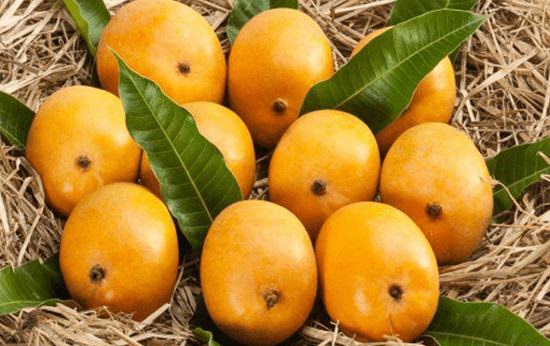
Taste: Intensely sweet and rich, almost honey-like
Flesh: Smooth, buttery, non-fibrous, bright orange
Often called the “King of Mangoes,” Alphonso mangoes are considered the best in terms of taste, texture, and aroma. Grown mainly in Maharashtra, especially in Ratnagiri and Devgad, this mango has a creamy consistency and a strong, sweet fragrance. It is often used in Indian sweets like mango shrikhand, lassi, and desserts. Alphonso mangoes are typically available from April to early June and are known for their premium quality and high price.
- Kesar Mango

Taste: Sweet and slightly tangy
Flesh: Deep orange, soft, and fiber-free
The Kesar mango gets its name from its saffron-colored pulp (“kesar” means saffron in Hindi). It is grown mainly in the Girnar Hills of Gujarat and is the second most exported mango from India. Kesar mangoes are loved for their consistent sweetness and are often used in mango pulp products, milkshakes, and desserts. Their harvest season begins in May and continues through July.
- Dasheri Mango

Taste: Sweet and highly aromatic
Flesh: Juicy, peach-toned, and smooth without fibers
Originating in Lucknow, Uttar Pradesh, the Dasheri mango is one of the oldest and most loved mango varieties in India. These mangoes are long, oval-shaped, and turn yellow-green when ripe. The soft, fiberless pulp melts in your mouth and gives off a delightful fruity fragrance. You can enjoy Dasheri mangoes fresh or use them to make jams, chutneys, and mango pickles. They are usually available from mid-May to August.
- Chausa Mango (Chaunsa)

Taste: Extra sweet and flavorful
Flesh: Rich yellow, soft, with very low fiber
The Chausa mango is a highly sought-after variety from North India and Pakistan. Known for its rich sweetness and juicy flesh, it’s a favorite for eating fresh or making mango drinks and desserts. Chausa season begins in June and peaks by mid-August. It’s so popular that it’s often exported around the world during its peak months.
- Bombay Green Mango
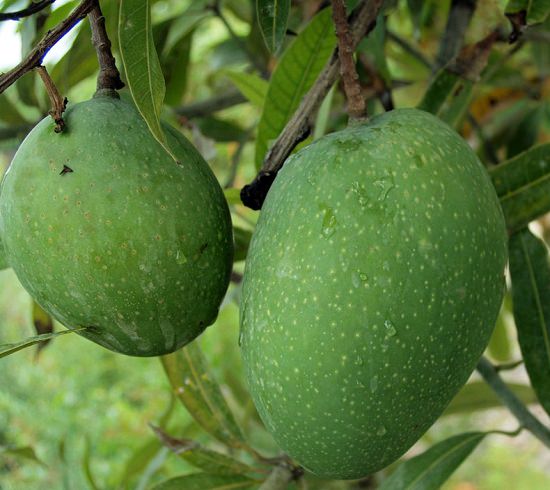
Taste: Sweet and subtly floral
Flesh: Firm, smooth, and fiber-light
Despite its name, Bombay Green is typically harvested while still green and ripens to a light yellow. These mangoes are small to medium in size, with a crisp texture and a strong aroma. Grown in North India, this variety is one of the earliest to appear in the summer season. They’re delicious when eaten ripe and also used in raw form for pickling or chutneys.
- Langra Mango
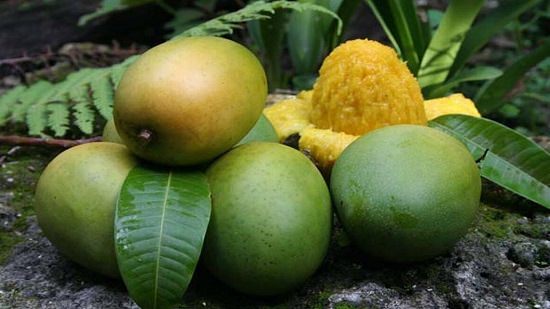
Taste: Sweet and distinctively tangy
Flesh: Soft, juicy, and nearly fiberless
Langra mangoes have a unique place in Indian culture and history. First cultivated in Varanasi (Banaras), this variety has been around for more than 250 years. The skin remains green even when ripe, and the fruit has a lemony tang that makes it stand out. It is grown widely in Uttar Pradesh, Bihar, West Bengal, and even in Bangladesh. Langra is a mid-season variety, typically available from June to early August.
- Amrapali Mango

Taste: Sweet with a complex flavor profile
Flesh: Deep orange-red pulp with moderate fibers
Amrapali is a hybrid mango developed by crossing Dasheri and Neelum varieties. It was created at the Indian Agricultural Research Institute and is popular for both home gardening and commercial farming. The fruit is small but intensely flavorful, with thick pulp and good shelf life. It is usually eaten fresh and sometimes processed into pulp or puree.
- Neelam Mango

Taste: Sweet with a hint of spice
Flesh: Semi-firm, juicy, fiberless
Neelam mangoes are known for their late-season availability and are one of the last varieties to hit the market, usually around June and July. They’re grown mainly in Andhra Pradesh, Tamil Nadu, and Karnataka. The fruit is medium-sized, with smooth yellow skin and a soft aroma. Because of its clean texture and good balance of sweetness, it’s often used in mango desserts and pickles.
Banganapalli (Safeda Mango)
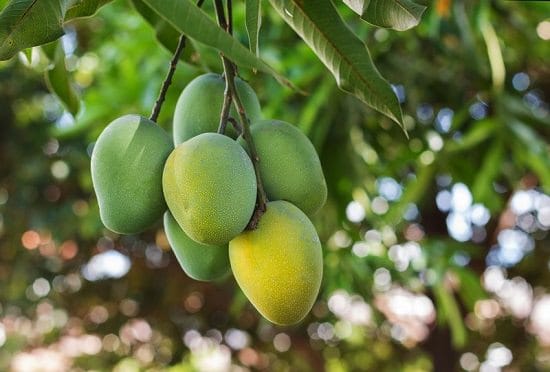
Taste: Sweet with a mild tang
Flesh: Firm, juicy, fiberless, yellow
Banganapalli, also known as Safeda, is one of the most popular mango varieties in southern India. Originating from the town of Banganapalle in Andhra Pradesh, this mango stands out for its smooth, fiberless texture and subtly tangy sweetness. It’s large, oblong, and bright yellow when ripe, often appearing early in the mango season. The firm flesh makes it excellent for slicing, and it’s often used in fresh fruit platters, mango lassi, and even for drying into mango slices. Its clean finish and rich juice content make it a staple in many homes and markets during the summer months. Banganapalli is also widely exported and is among the most recognizable Indian mangoes worldwide.
Chok Anan

Taste: Mildly sweet
Flesh: Firm, yellow, low to no fiber
Chok Anan is often called the “Miracle Mango” for a good reason—it bears fruit twice a year, once in summer and again in winter. This mango is originally from Thailand but is now grown in parts of India and Pakistan as well. It has a large, oval body with a slightly pointed tip and ripens to a golden yellow color. The flesh is firm and not overly juicy, with a mild sweetness that makes it a hit with those who prefer a lighter flavor. Its smooth texture and easy-to-peel skin make it great for both kids and adults. Chok Anan is also favored by home gardeners because of its consistent yield and smaller tree size, making it ideal for backyard cultivation.
Badam Mango

Taste: Sweet and buttery
Flesh: Juicy, soft, yellow, no fiber
The Badam mango is a southern Indian favorite known for its richness and flavor that’s often compared to the legendary Alphonso. Though its name means “almond” in Hindi, there are no nuts involved—just a deliciously smooth and creamy bite that melts in your mouth. These mangoes have a thin, pale yellow skin and a light golden pulp that is completely fiberless. The sweetness is intense but not overwhelming, and the flavor is well-rounded with a hint of floral aroma. It’s commonly enjoyed fresh or used in desserts like mango mousse and ice cream. Because of its appealing appearance and perfect texture, it’s a top pick for both personal use and gifting.
Totapuri

Taste: Sweet and sour
Flesh: Firm, crisp, no fiber
Totapuri mango is one of the most widely available mangoes in India and is especially popular in the south. It gets its name from its unique parrot-beak shape—“Tota” means parrot in Hindi. The skin is greenish-yellow and slightly tart even when ripe. The flesh inside is crisp, juicy, and completely fiber-free. Unlike many other mangoes, Totapuri is often eaten when it’s still unripe, sliced and sprinkled with salt and chili powder as a tangy snack. It’s also used in pickles, juices, and pulp production because of its high yield and strong flavor. This mango’s balance of sourness and sweetness makes it a versatile ingredient in many Indian kitchens.
Sindhri
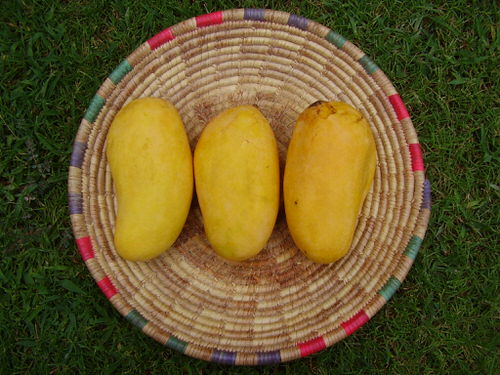
Taste: Very sweet and aromatic
Flesh: Deep yellow, soft, smooth
Sindhri mangoes are a celebrated variety from Pakistan’s Sindh province, often called the “King of Mangoes” there. These mangoes are large, oval, and can grow up to 8 inches long. Their soft, buttery flesh is incredibly sweet and filled with juice, making them a real summer indulgence. The skin is thin and smooth, usually a pale yellow that deepens as it ripens. What makes Sindhri truly special is its strong fruity aroma that fills the room even before cutting into it. They are best eaten fresh, and due to their large size, just one mango can be a satisfying treat on a hot day.
Raspuri
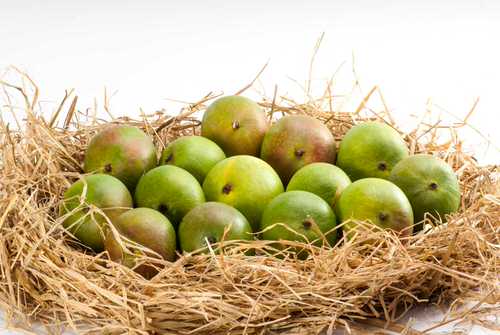
Taste: Warm, sweet with a slight tart note
Flesh: Bright yellow, juicy, smooth
Raspuri mangoes are a regional favorite in Karnataka, especially around the Old Mysuru region. Oval-shaped and medium-sized, they are known for their juicy texture and full-bodied flavor. Raspuri mangoes often have a yellow skin with reddish patches, making them quite attractive. Their taste is rich and layered—mostly sweet, with a pleasant tanginess that adds depth. They’re widely used in making mango shakes, yogurts, jams, and even ice creams. Because of their naturally soft and juicy pulp, they blend smoothly and add a tropical flair to many recipes. These mangoes are harvested during the peak summer months and are loved for both home consumption and processing.
Anwar Ratol

Taste: Pleasantly sweet and fragrant
Flesh: Firm, yellow, smooth
Anwar Ratol is a highly prized mango from the northern regions of India and Pakistan. It originated near the village of Rataul in Uttar Pradesh and is also widely grown in Punjab and Sindh. Although smaller in size compared to other varieties, it’s famous for its silky-smooth pulp and rich aroma. The flavor is deeply sweet but not overpowering, making it a favorite for both children and adults. The mango has a delicate skin and ripens into a bright yellow hue. It’s often eaten as is or used in desserts and milk-based drinks. Due to its limited harvest window, Anwar Ratol is considered a premium, seasonal delight.
Himsagar
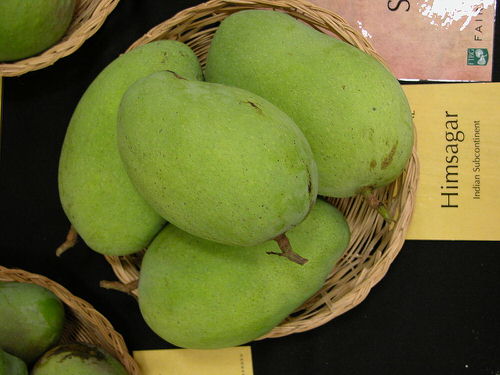
Taste: Intensely sweet and flavorful
Flesh: Yellow, creamy, non-fibrous
Himsagar mangoes are a treasured variety from the eastern Indian states of West Bengal and Odisha. Known for their rich, custard-like pulp, these mangoes are relatively small but pack a powerful flavor. The skin turns golden yellow with a red blush when ripe, and the inside is filled with smooth, creamy flesh that melts in your mouth. Himsagar mangoes are generally harvested in May and are only available for a short period. Because of their dense sweetness and low water content, they are a top choice for milkshakes, desserts, and direct consumption. They are considered one of the most premium table mangoes in eastern India.
Malgoba
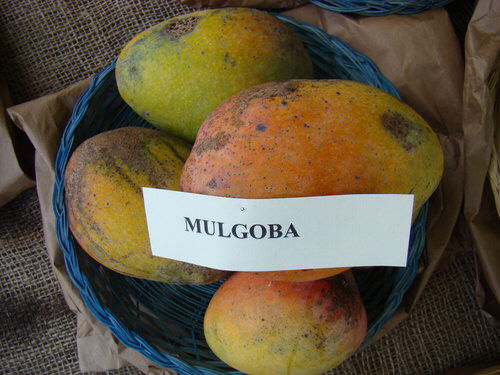
Taste: Juicy and mildly spicy
Flesh: Light yellow, soft, with a small seed
The Malgoba mango is a lesser-known gem from Tamil Nadu and parts of Karnataka. These mangoes are large, rounded, and turn greenish-yellow when ripe. The taste is a mix of rich sweetness with a subtle spicy undertone, making it different from most common varieties. Its soft flesh is juicy and thick, surrounding a surprisingly small seed, which means more pulp in every fruit. Malgoba mangoes are often used in curries, pickles, and sweet chutneys due to their strong flavor. Their balanced taste makes them versatile, enjoyable when both ripe and semi-ripe.
Pairi (Paheri Mango)
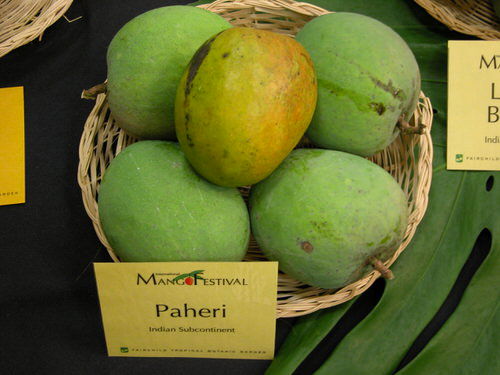
Taste: Sweet, slightly tangy, very juicy
Flesh: Bright yellow, smooth, fiberless
Pairi, also known as Paheri, is a seasonal mango variety mostly found in Maharashtra and parts of northern India. It’s known for its refreshing taste and high juiciness. These mangoes are medium-sized with golden-yellow skin, sometimes with a red blush. The pulp is smooth and bright, making them a joy to eat fresh or blend into summer drinks. Their sweet and slightly sour flavor is deeply satisfying and has made them a favorite among mango purists. Because they arrive earlier in the season, Pairi mangoes often mark the beginning of mango celebrations across many Indian households.
Lakshmanbhog
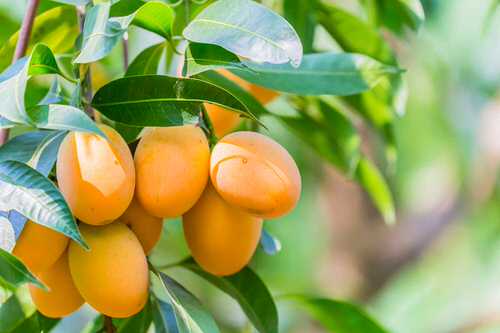
Flavor: Sweet and juicy
Flesh: Yellow-orange, firm and juicy, fiberless
Lakshmanbhog mangoes are grown exclusively in the Malda district of West Bengal and are typically available during June and July. These mangoes are medium to large in size, with a golden-yellow to orange skin that often has a slight blush. Inside, the pulp is dense and aromatic, offering a rich, syrupy flavor that lingers. The fruit is fiberless, making it smooth and easy to enjoy. Lakshmanbhog is one of the few Indian mangoes exported to the United States annually, so it’s not uncommon to find it in specialty stores abroad during mango season.
- Fazli
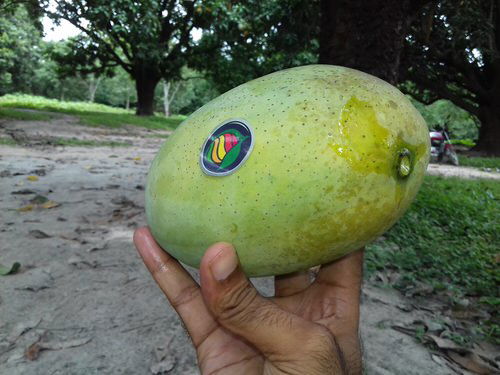
Flavor: Very sweet and juicy
Flesh: Light yellow, firm yet tender, aromatic
Fazli mangoes are known for their enormous size—some weighing over a kilogram each. Native to eastern India, especially West Bengal and parts of Bangladesh, this late-season mango is harvested in July and August. Its generous size means plenty of juicy pulp, which is mildly sweet and subtly fragrant. Fazli’s firm flesh holds up well in processing, making it a top choice for mango pulp, jams, and preserves. It’s especially prized in regional cuisines for its refreshing flavor and availability after most other mangoes are gone from the markets.
- Imam Pasand

Flavor: Exceptionally sweet with a tangy aftertaste
Flesh: Creamy, fiberless, soft pulp beneath thick skin
Imam Pasand is a royal favorite from southern India, especially Tamil Nadu and Andhra Pradesh. These mangoes are large and oval-shaped, often weighing up to 750 grams each. The skin starts green and becomes a yellow-green as it ripens, sometimes with speckles. The inner pulp is luscious and smooth, delivering a burst of complex sweetness with a hint of citrus-like tang. This variety is treasured for its delicate, melt-in-your-mouth texture and unique flavor profile. Due to its short season and limited cultivation, it is considered one of the more exclusive mango types.
- Mallika
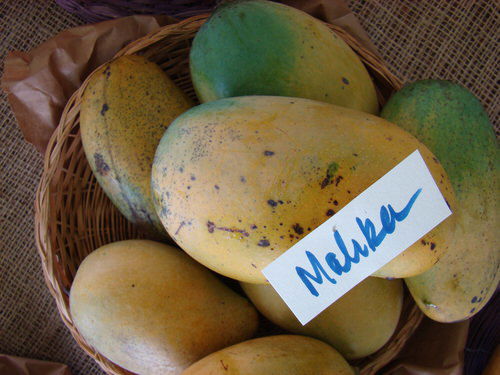
Flavor: Intensely sweet and fragrant
Flesh: Deep orange, smooth, fiberless
Mallika mangoes are a hybrid between the Neelum and Dasheri varieties, developed for their exceptional sweetness and firm, fiber-free flesh. These mangoes ripen during mid-summer and are known for their bright orange color and concentrated mango aroma. Mallika is often grown by home gardeners and commercial growers alike because of its disease resistance and good yield. While excellent when eaten fresh, they also make flavorful additions to mango sorbets, smoothies, and salsas due to their bold taste and creamy texture.
- Mankurad
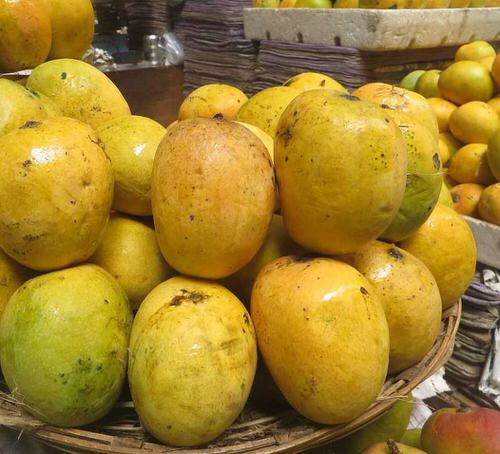
Flavor: Richly sweet and juicy
Flesh: Yellow, dense pulp with a small seed
Mankurad, also known as Goa’s premium mango, is a mid-season favorite found mostly in western India. It’s smaller than Alphonso but packs a sweeter punch, often described as more natural and less processed in taste. These mangoes are usually round with a golden-yellow skin and have minimal fiber, which makes their pulp smooth and satisfying. One of their unique features is the small, flat seed that allows for more edible fruit per mango. Mankurad is best eaten fresh, straight off the tree, or paired with yogurt or chilled cream.
- Vanraj

Flavor: Sweet, tangy, and highly aromatic
Flesh: Bright yellow, juicy, soft
Vanraj mangoes are a rare and cherished variety grown in Gujarat, particularly around Vadodara. Their deep, reddish-purple blush over a yellow base makes them visually stunning, while their flavor is equally impressive—a mix of sweet and sour with a rich mango scent. The flesh is juicy, with a silky texture that makes them ideal for juicing or simply enjoying as a summer snack. Due to their limited production and strong local demand, Vanraj mangoes can be relatively expensive, but for many mango lovers, they’re well worth the splurge.
- Gulab Khaas

Flavor: Sweet with a floral rose-like note
Flesh: Yellow, smooth, fiberless
Gulab Khaas is a small-sized mango known for its unique, rosy fragrance that gives it the name—‘Gulab’ meaning rose in Hindi. It is mostly cultivated in parts of West Bengal, Bihar, and Jharkhand. The fruit has smooth skin that often shows a reddish or pink hue, adding to its appeal. The pulp is soft, juicy, and free of fiber, with a distinct floral sweetness that sets it apart from other varieties. Gulab Khaas is generally available from May to early June and is popular both as a dessert mango and in mango-flavored sweets.
- Kilichundan
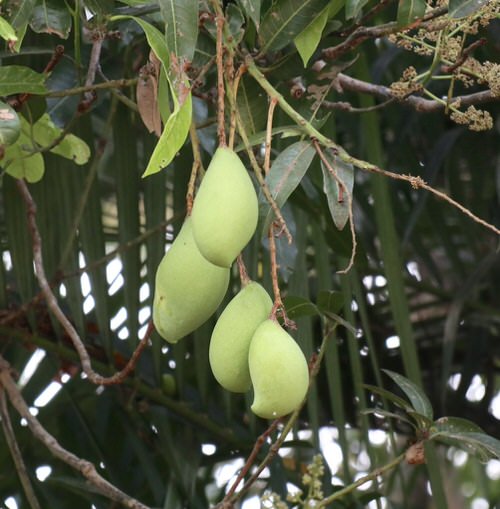
Flavor: Mildly sweet and highly fragrant
Flesh: Greenish-yellow, smooth, moderately juicy
Kilichundan, which translates to “bird’s beak” in Malayalam, is a southern Indian mango variety recognized by its pointed tip. These mangoes are medium to large in size and are initially green with a firm feel. As they ripen, the skin turns to a golden yellow, and the inner flesh becomes tender and more flavorful. The taste is gentle—less sweet than other varieties—but the aroma is strong and pleasing. Kilichundan is popular in Kerala and surrounding regions, where it’s used in both fresh preparations and traditional pickles due to its balanced flavor.
- Rumani

Flavor: Very sweet and juicy
Flesh: Smooth, golden-yellow pulp
Rumani mangoes are mostly grown in northern Andhra Pradesh, India. They are medium-sized fruits with a bright yellow skin when ripe and a smooth, golden flesh inside. These mangoes are often called “ice-cream mangoes” because of their rich, dessert-like flavor and soft texture. They are best enjoyed fresh and are popular in local markets during the peak summer months.

